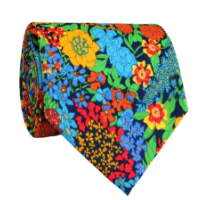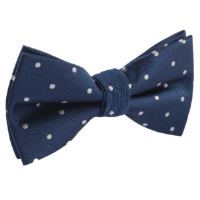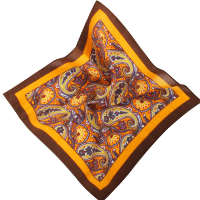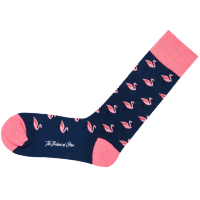How to Dress Like Frank Sinatra

His nicknames include "Ol Blue Eyes," "Sultan of Swoon," "Swoonatra," and simply "The Voice." Few celebrities could rival Frank Sinatra's influence and sway even today. He was a legendary singer, actor, and fashion icon (think polka-dot dress shirts, fedoras, and expertly knotted neckties).
Sinatra will continue to be remembered not only for his indelible marks on the music industry and pop culture but also for his impeccable personal style. Let's review the man's life and unique sartorial tastes.
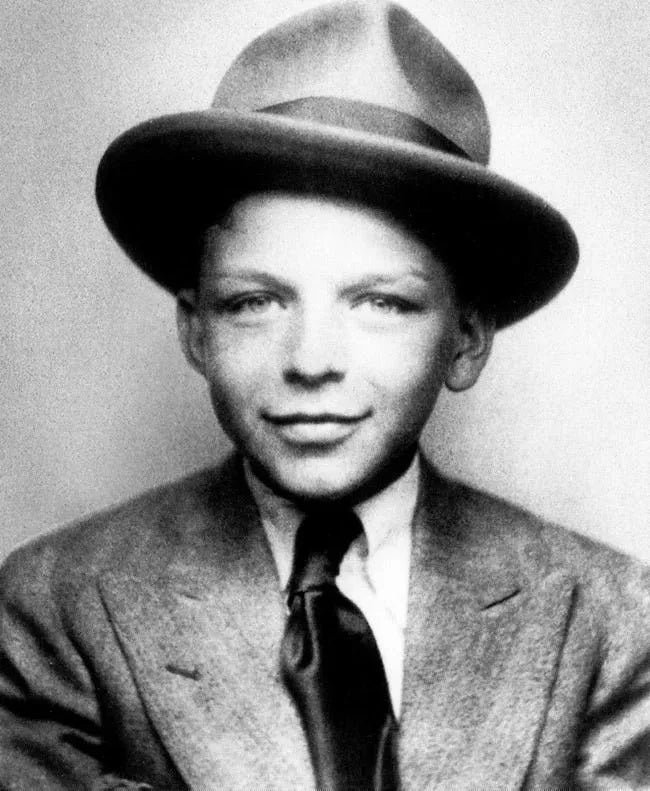
(Frank Sinatra, possibly in his late 20s as a young child)
Frank Sinatra's early years
Born Francis Albert Sinatra on December 12, 1915, to Italian immigrants, Frank Sinatra's father was a professional boxer and later a firefighter, while his mother was a midwife influential within his hometown of Hoboken, New Jersey. At a very early age, he was interested in big band and jazz music. He used his singing voice to get through his early days, earning minor pay for amateur gigs.
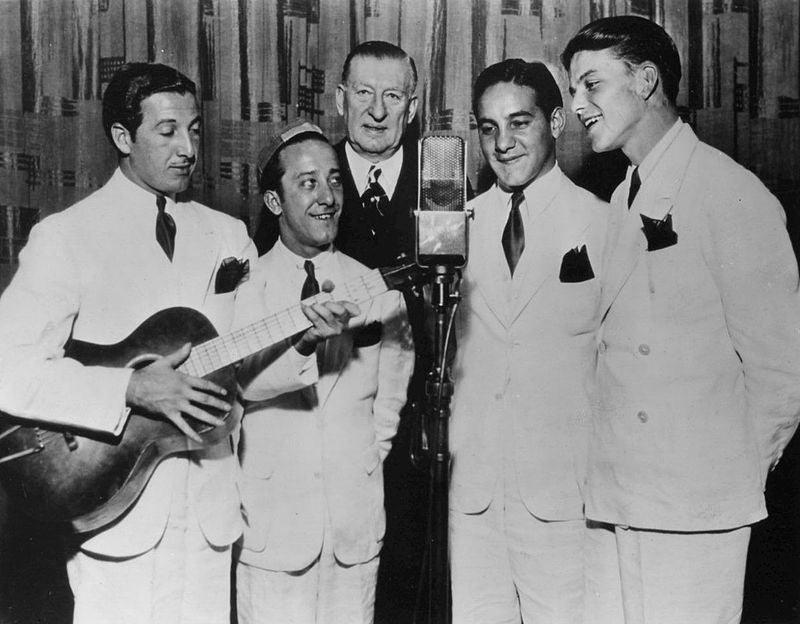
(Frank Sinatra, far right, with the Hoboken 4 and with Major Bowes in the background)
In 1935, he started his professional singing career by entering a local band called the 3 Flashes, which became the Hoboken Four when he joined. The group succeeded, winning a contest on the Major Bowes Amateur Hour show. The first prize was a six-month contract to perform on stage and radio across the United States.

(Frank Sinatra, right, performing with Harry James (left) and the rest of his band, 1939)
In 1939 Frank Sinatra joined the Harry James band and released his first commercial record, "From the Bottom of My Heart." Unfortunately, this and other records had weak sales that year.

(Frank Sinatra (on top row, right-most corner) with the Tommy Dorsey band, with Tommy Dorsey holding his trademark trombone and glasses, 1940)
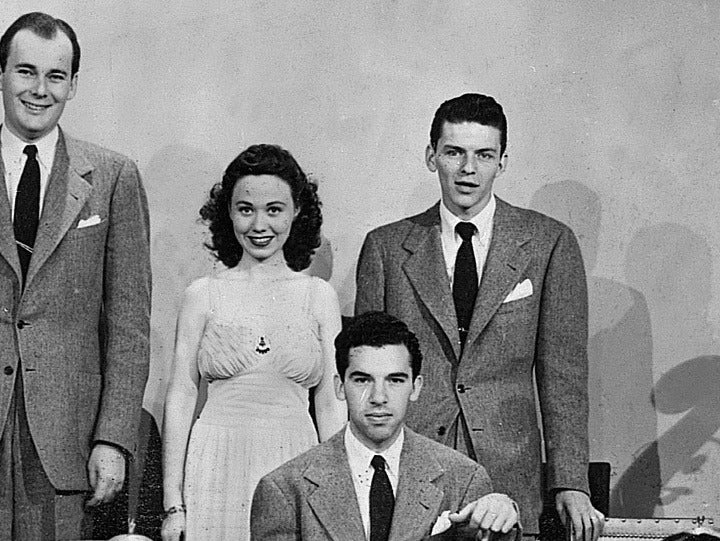
(Frank Sinatra, close-up of the previous photo)
Sinatra finds a mentor.
In November 1939, Frank left the band to join the Tommy Dorsey band. He made several appearances with them over the following years, where he found his first major successes in his career, starting with the songs "Polka Dots and Moonbeams" and "Imagination," which would become his first top 10 hits.
The band's founder, Tommy Dorsey, took him under his wing for guidance and allowed him to record a few solo records. His successes in solo records convinced him he needed to continue alone, which he did in late 1942, leaving the band to make a name for himself.

(Frank Sinatra (left) in a conversation with drummer Buddy Rich (centre) and his mentor Tommy Dorsey (right), 1941)
In addition to the advanced music techniques that helped him define his iconic singing style, Frank Sinatra adopted Dorsey's fashion style. This style stayed with him for many years, becoming iconic as he put his spin on it, combining classic menswear with bold and subtle touches that added contrast and personality.
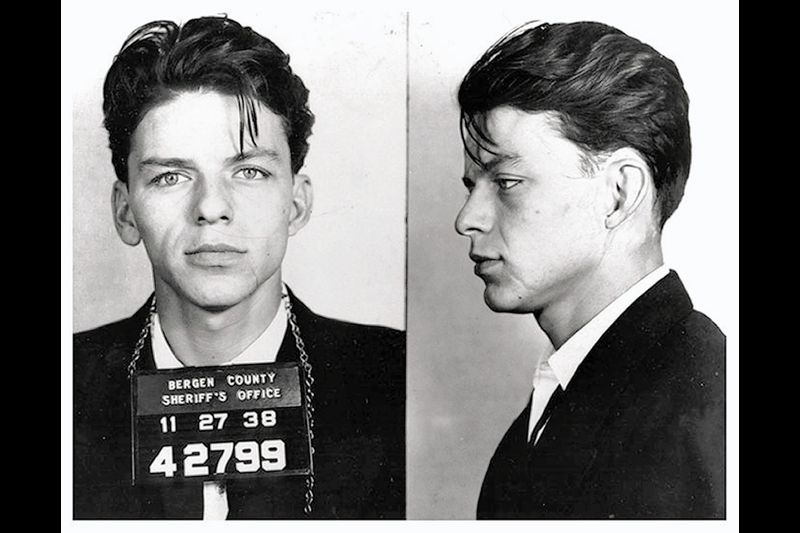
(Frank Sinatra, in his youth, in a police mug shot, was arrested for seduction and adultery - he was only 23 years old)
Ol' blue eyes hone his style.
Frank Sinatra's suits were always a little oversized to keep with the fashion at the time. Still, length-wise, they were all meticulously tailored — the shirt cuff should extend half an inch from the jacket sleeve, and the trousers should break just above the shoe. This emphasis on tailoring created a "Goldilocks" fit — neither too slim nor too loose — that made his suits timelessly elegant, contributing to his dapper image.
In this manner, he exuded an air of effortless elegance while effortlessly dressing down anytime he wanted. During his later heydays, Sy Devore made most of his suits.
Sinatra's signature pieces were his fedoras, high-waisted trousers, and knitwear, particularly cardigans. These items were consistent in his public appearances and became synonymous with his image.
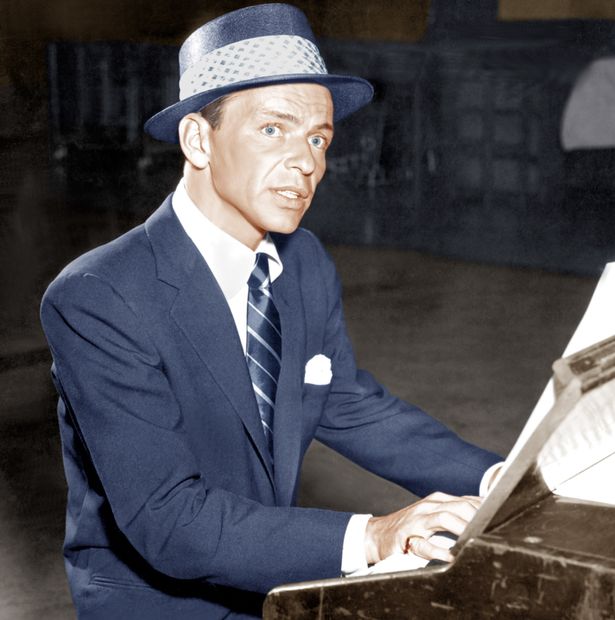
(Frank Sinatra, playing the piano while wearing a navy-blue suit with notch lapelled jacket, also wearing a satin blue and silver striped tie, white pocket square and his trademark fedora, for a television production of "Our Town" in 1955)
In keeping with norms, his pants were usually high-waisted, which worked well with Sinatra's whip-thin frame. The proportions were guaranteed to look more elegant by emphasising his already thin waist and giving an illusion of longer legs and height.
Sinatra was also known for his sharkskin suits, which were made from a mix of mohair and wool. These suits gave his outfits a sleek and contemporary look suitable for high-profile occasions like black-tie events. This fabric choice added a subtle texture to his refined style, setting him apart in fashion.

(Frank Sinatra, with dark grey barleycorn patterned high waist pants, knit button suspenders, gold cufflinks and untied black bow tie)
In keeping with norms, his pants were usually high-waisted, which worked well with Sinatra's whip-thin frame. The proportions were guaranteed to look more elegant by emphasising his already thin waist and giving an illusion of longer legs and height.
Sinatra was also known for his sharkskin suits, which were made from a mix of mohair and wool. These suits gave his outfits a sleek and contemporary look suitable for high-profile occasions like black-tie events. This fabric choice added a subtle texture to his refined style, setting him apart in fashion.
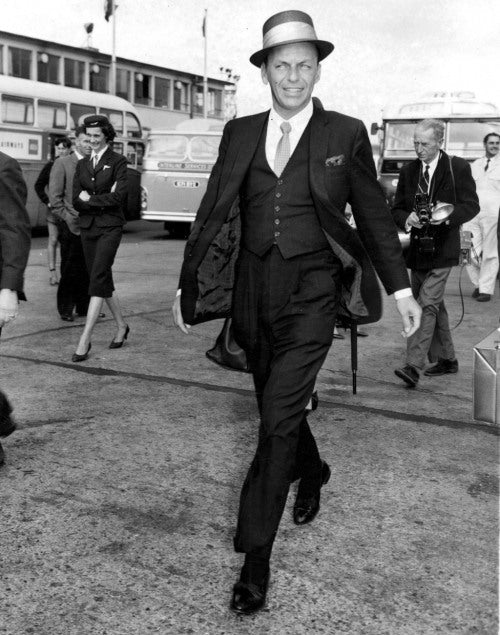
(Frank Sinatra wearing a dark flannel three-piece suit with a single-breasted, notch-lapelled jacket and a low cut five-button waistcoat with a notched bottom. Also wearing double reverse-pleated trousers, dark patterned silk pocket square, lapel pin, necktie with a repeating series of light circles against a dark ground. Topped with a dark-coloured straw short-brimmed trilby hat with a broad white puggaree ribbon. Photographed at Heathrow Airport, mid-1961)
how to dress like Frank Sinatra
Concerning the colour of his suit, Sinatra believed that men should wear dark suits (except dark brown) at night but would often wear grey and blue suits and plaid and pinstripe ones during the day. Concerning patterns, Sinatra's bold yet controlled use of pinstripes and polka dots demonstrated his ability to balance sophistication with visual interest, making his outfits stand out without overwhelming the viewer.
Another takeaway from Sinatra's style? When in doubt, go for a black tie, except on Sundays. The crooner was known for dressing to the nines for any occasion, cementing his status as a fashion icon worldwide.
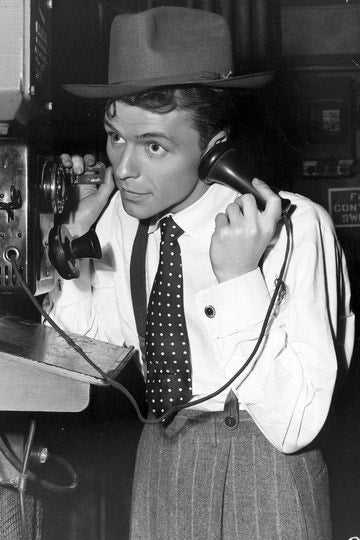
(Frank Sinatra, posing on the phone, wearing grey flannel pants with white pinstripes, dark button suspenders, dark satin tie with white polka dots, onyx set gold cufflinks and a trilby hat cocked to one side, possibly about early 1942)
Sinatra would sometimes wear pinstripes with a polka-dot tie if he chose a pattern for his suits. This way, the pinstripes would give an illusion of height, and the tie would emphasise his chest. The two patterns are the most straightforward on the sliding pattern scale.
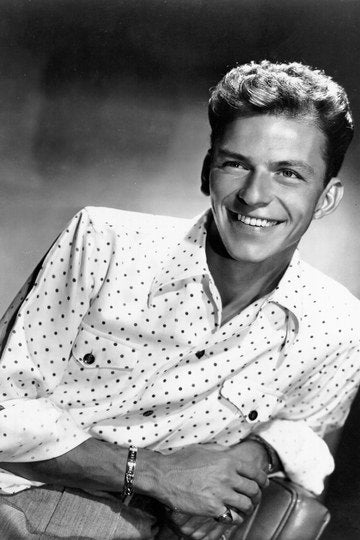
(Frank Sinatra, posing in studio wearing a white shirt with black polka dots, flap button pockets, and grey flannel pants, 1945)
Sinatra sometimes wore polka-dot shirts, which again emphasised his chest. This style works in both casual and formal settings.
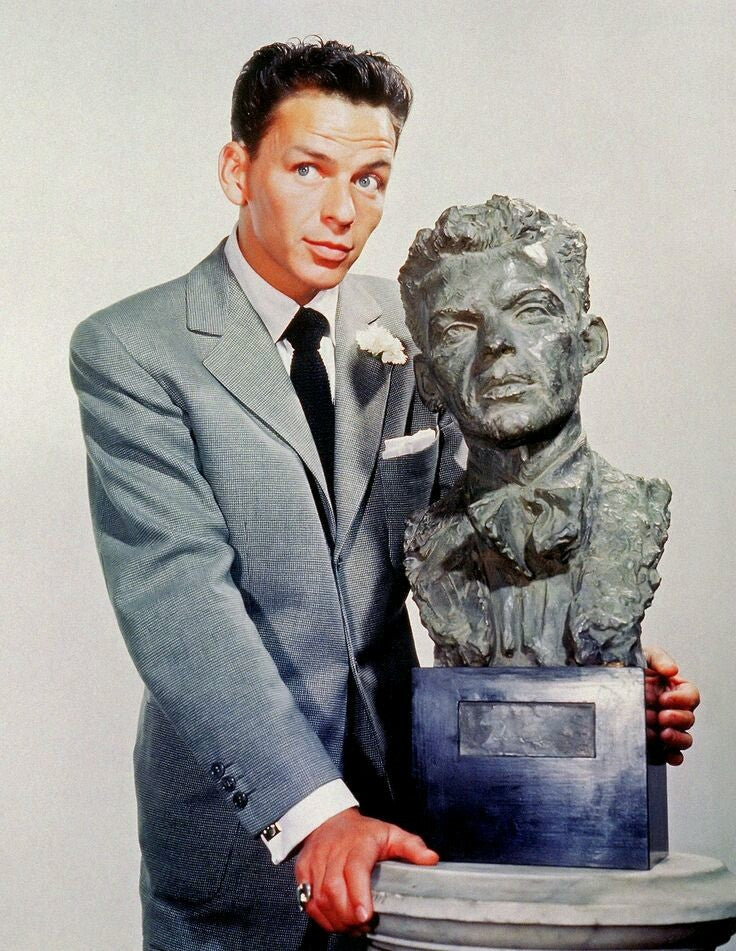
(Frank Sinatra, photographed with a sculpture of him made by Jo Davidson, wearing a checked grey suit with a navy blue knit tie and gold cufflinks, 1946)
Because of the proportions of the length of his sleeves, cufflinks were essential in Sinatra's outfits, and he preferred him in simple gold. His use of accessories, such as narrow-brimmed fedoras, silk ties, and pocket squares, helped unify and personalise his looks. These carefully chosen elements elevated his outfits.
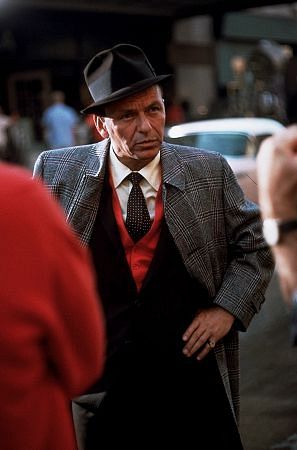
(Frank Sinatra here wears a glen-checked grey overcoat, black suit, black tie with white polka dots and an orange waistcoat. Topped with a dark brown trilby hat. On the set of "Come Blow Your Horn," 1963)
Frank Sinatra's signature look
While Sinatra wore many different ties in different patterns and colours, he always tried to include his favourite colour, orange, somewhere in his outfit because, according to him, "orange is the happiest colour." Usually, it was in the form of an orange pocket square, crisply folded.
Sinatra also had a knack for adding individuality to classic formalwear. He would sometimes opt for a brocade waistcoat or a velvet ribbon instead of a classic bow tie, ensuring that even his most formal outfits had a unique twist that kept his look fresh and exciting.

(Frank Sinatra here wears a dark suit with a notch-lapelled jacket, satin speckled dark necktie, a lighter-coloured trilby hat, and a pair of black patent leather derby shoes. Shown here during a capitol studio session in 1957)
As for shoes, he usually wore black patent shoes, reserving brown shoes for informal or daytime wear. Sinatra would go out of his way to ensure his pair were always polished. Derby and patent slip-on shoes were his usual go-to's.
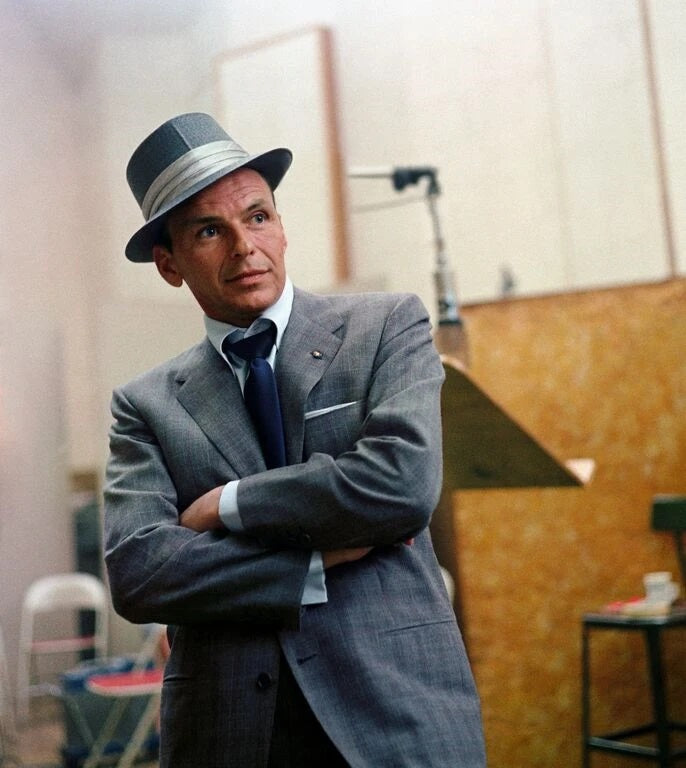
(Frank Sinatra wearing a grey flannel suit with a wide notch-lapelled jacket, gold lapel pin, royal blue satin skinny tie, and a grey fedora with a wide ivory silk hat band. Seen here in a studio session at Capitol Records, 1954)
Sinatra was rarely seen without his hat cocked to one side — it became one of his signature looks. During that time, hats were a quintessential item in men's fashion, and finding a hat that suited you the best was a separate art altogether. However, most of Sinatra's hats are Cavanagh hats. He preferred fedoras since the wide brim worked well with his head shape.
an American legend
Frank Sinatra's style and that of the Rat Pack significantly impacted American culture. Their sartorial choices became synonymous with mid-century elegance, influencing generations of men's fashion. Even today, Sinatra's approach to style inspires people, reflecting a timeless quality that will remain relevant and admired for years to come.


